Squatting With Plates Under Heels: Benefits Explained
Author:
Reviewed by:
(21 years of Oly Lifting experience)
Unlock your full potential by engaging with our experts and community! Have questions about your fitness journey or looking for expert advice on weightlifting techniques? Don’t hesitate — leave a comment below and Sergii Putsov will provide a personalized answer and insights to help you reach your goals.
Torokhtiy is reader-supported. Some links are affiliate links, and we may earn a commission at no extra cost to you. See our disclosure page for details.
As we go through this article we’ll unlock more knowledge on a type of squatting that could add tons of benefits and gains to your squat ¨squatting with plates under heels¨. From enhanced strength in the squat to better biomechanics, we’ll discover all the benefits and also drawbacks that squats on plates will bring to your training sessions. Get ready to unlock the secrets of squats with heels on plates.
Do Elevated Squats on Plates benefit your leg day sessions? Yes, squatting with plates under heels can be quite useful for working on our goal of having heavier squats, its benefits go from improving your ankle mobility, enhancing your range of motion by letting you squat deeper, bettering your posture.

Squatting with plates under the heels: general characteristics, biomechanics of the movement
When we’re talking about squats with plates under heels we’re usually referring to one of two needs or purposes, addressing limited ankle mobility or facilitating having a more upright torso when squatting. The general need for this is elevating the ankles from the floor and reducing the ankle dorsiflexion (bringing your toes to your shins).
You can do this by different means, most common is placing plates under the heels, but you can also wear weightlifting shoes which always have a raised heel. Athletes with a limited ankle flexibility use this technique to optimize their squat form, and to name a few of its benefits we can say that it improves ankle dorsiflexion, helps you squat deeper while having a more upright torso.
Analyzing the squat with elevated heel we can see several changes from a flat feet squat, for example, quadriceps engagement, having heels elevated emphasizes the engagement of the anterior muscles of the lower body. Also, for some it can reduce the stress squatting has on their knees, by accommodating the limited ankle mobility they may have and reducing the stress it has on their knees.

Adding that it can also help you squat deeper which can be an advantage if you’re trying to target specific muscle groups by achieving a longer range of motion. In the same area of squatting deeper we have that squatting on an inclined surface, such as elevating heels will give you, will promote a more vertical torso because it reduces the tendency to learn forward, this can have many benefits because it promotes having a proper spinal alignment.
It is important to note that while squats on plates have many benefits for certain athletes, it may not be universally suitable. Before having this as a squat alternative, you should assess your comfort, biomechanics and training goals to determine if this technique or hack is aligned with your needs. As with any squat variation, a proper form and gradual progressions are the key to maximizing the benefits of your workouts and minimizing the risk of injury.
8 Benefits of Doing Elevated-Heeled Squats
✅Improved Ankle Mobility
When you elevate your heels in a squat you’re helping mitigate the ankle mobility issues you could have, because it will lower the need for dorsiflexion which is one of the biggest difficulties some athletes have. If you’re on the journey of improving your mobility, you should check our Full Squat Mobility Program.
✅Enhanced Range of Motion
Using plates under the heels helps you achieve a deeper squat by altering the angle of the ankles and allowing you to have a more vertical torso. This longer range of motion is a huge advantage for targeting specific muscle groups, such as the quads and glutes, giving you a better workout and helping you have stronger legs.
✅Targeted Muscle Activation
Having heels elevated makes you have a bigger emphasis on the quadriceps and glutes. The altered biomechanics shifts the load toward the anterior muscles of the lower body, helping you have a more balanced development of your strength. This targeted activation is of high values for those athletes looking for an isolated strength workout.
✅Better Posture
Elevating the heels makes it easier to have a more vertical torso during the squat. It will promote a more aligned spine, reducing the risk of leaning forward. Improved posture not only enhances the effectiveness of your squat but it will also contribute to overall spinal health and will lead you to reduced likelihood of lower back pain.
✅Reduced Stress on Knees
For athletes that suffer from pre-existing knee issues or lack proper ankle mobility, squatting with heels on plates can help minimize the stress that squats can have on their knees. By helping them with their ankle restriction, this technique will reduce the strain squatting has on their knees, making this a suitable alternative for those with mobility limitations or discomfort.

✅Optimized Biomechanics
Altering the angle by elevating the heels optimizes the squats biomechanics. It encourages a smoother and more controlled movement pattern at the same time that it reduces the risk of compensating in the movement, like shifting your weight to the toes or raising the hip before the shoulders. This enhances the overall effectiveness of the squat while minimizing the risk of injury at the same time.
✅Varied Training Stimulus
Incorporating the heels on plates squat can introduce a new stimulus to the muscles, adding this new challenge will prevent plateauing and promote a continuous improvement in strength, endurance and overall squat strength.
✅Adaptability
Squats standing on plates is adaptable for athletes with specific anatomical considerations like ankle mobility or maybe unique joint structures. It will also help as a transitional step for those considering moving to weightlifting shoes, allowing them to gradually adjust to the altered foot positioning.
6 Drawbacks of Doing Elevated-Heel squats
❌Forward Torso Inclination
While we named this as a complete opposite benefit of this technique, the possibility that elevated heels could make you have a forward torso inclination is there, for athletes with a possible restriction of hip mobility could still lack the ability to squat with a fully upright torso possibly adding additional strain on the lumbar spine. Athletes need to be cautious about maintaining a proper vertical torso posture and avoiding an excessive forward lean to lower the risk of lower back pain and strain.
❌Limited Ankle Dorsiflexion Improvement
While squatting with heels on plates primarily helps athletes with limited ankle dorsiflexion rather than helping address the cause of the problem. Athletes with this limitation may find that this technique is a temporary solution. A better approach is to incorporate ankle mobility exercises as well as the elevated heels squats.
❌Dependency on External Support
Relying on elevated heels during your squats can potentially stop your natural development of ankle mobility. With time, athletes can become dependent on external aids, limiting their performance and ability to perform squats without the help of elevated heels. This technique is a temporary solution to these problems, we advise all athletes to target the issues that lead them to try the heels on plates squats.
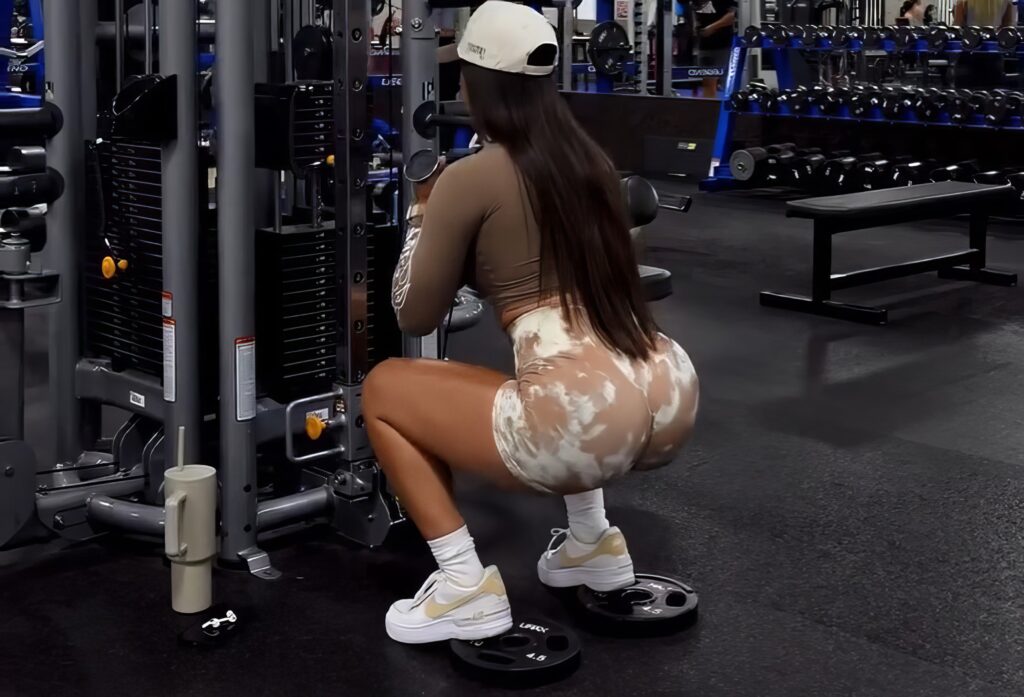
❌Foot Stability
Squats with heels on plates could compromise the foot stability, affecting and changing the balance during squats. Athletes that are not accustomed to the altered stance can have difficulties in maintaining proper foot positioning. We recommend incorporating stability exercises and gradual adaptation to the new foot placement, helping mitigate the risk of instability.
❌Equipment Dependency
This technique requires specific equipment, such as plates or weightlifting shoes. This dependency on specialized gear or equipment can present a challenge with training in different environments without access to this equipment. We should be mindful of this when incorporating this exercise into our routine.
❌Skill Transfer Issues
All athletes that rely on having elevated heels when squatting could encounter a challenge if they want to transition to other squat variations like low bar or front squats. These variations present a different mechanic to the movement that requires additional adaptation. Incorporating a variety of squat techniques into your training program can enhance your overall strength and versatility.
How to perform elevated squats correctly? (give a step-by-step guide)
1. Equipment Needed:
Weightlifting shoes or shoes with an elevated heel,
Weight Plates or an elevated surface.
🔻GET A FREE PROGRAM DEMO: 12 Week Squat Program by Oleksiy Torokhtiy

Do you want to double your squat strength? In just 12 weeks, you’ll be able to boost your squat results.
Enter your details and get a free demo (1 free week) of the squat program straight into your inbox.
2. Steps:
1) Set Up:
To start we’ll have to find some weight plates (or an elevated surface), preferably if you’re using plates, it’ll be better if they were regular size plates so they’ll be more stable on the floor and you’ll be sure they won’t slide anywhere while you’re squatting.
Start with your feet shoulder width apart or slightly wider if you need to, toes will be pointing slightly outwards. Remember, there are some variations of the heel elevated squat that ask you to have your feet closer together.
2) Positioning:
Position your barbell on your upper back (high bar position) or across the front of your shoulders if you’re performing front squats. Always remember to brace your core and engage your shoulders up so you have a more stable position, always maintaining a neutral curvature of your spine.
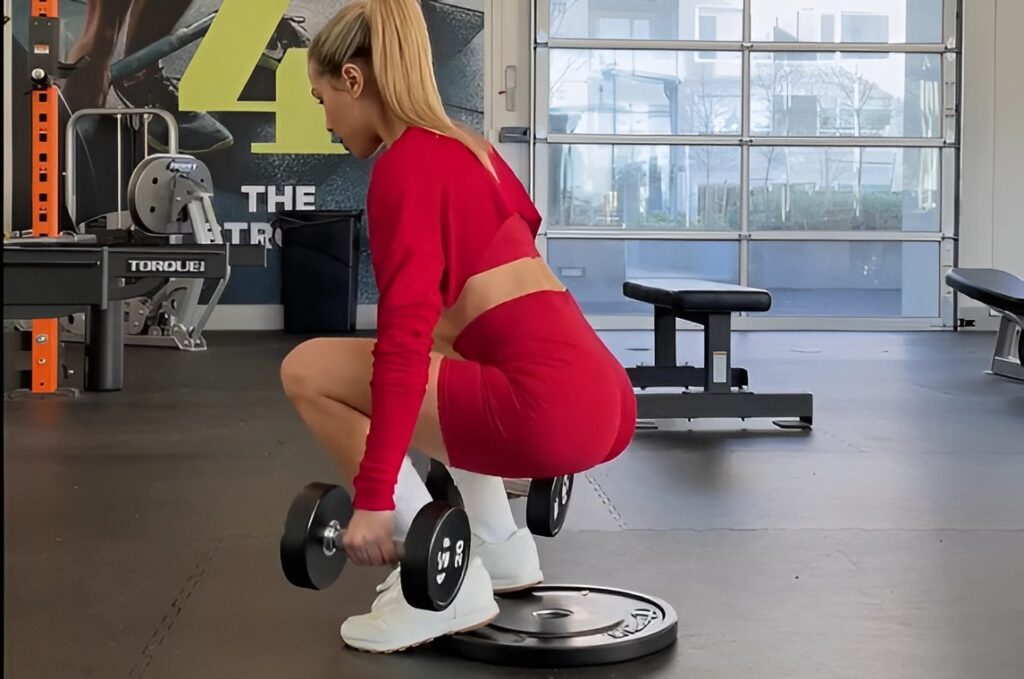
3) Initiate the Squat:
To start your squat, first start descending with your hip back first, immediately after that start bending your knees and descend down until you reach your desired depth of the squat you’re performing. During the whole squat you have to keep your heels on the elevated surface or plates.
4) Depth:
This one will always depend on your goal, when we’re talking about a full squat, we’re descending until your hip crease gets lower than your knees, this is what we call a full squat.
5) Upright Torso:
We’ll always aim to keep an upright torso during the whole squat, try thinking about keeping your chest up or ¨showing your shirt¨.
6) Drive Through the Heels:
Same as when descending on the squat as when you’re coming up from it, always think or focus on driving through the heels, this will help you keep an upright position and engage the muscle groups you’re aiming to work.
7) Hip Extension:
The full extension of the hip at the end of the squat is also part of the range of motion, think about squeezing your glutes at the end of the squat.
Follow us!

Free!
Get a 2-week Weightlifting Program as a bonus for the subscription to kickstart your training plan!

Free!
8) Breathing:
Breathing or proper breathing through the squat is one of the main things we need to focus on, a proper breath and bracing your core keeping tension on your muscles will help you not only squatting easier but also will keep you safe from losing the natural curvature of the spine.
9) Repetition:
Changing breaths and keeping your core tight through every repetition you intend to do. Try to keep yourself tight and you can also try to avoid bouncing at the bottom of the squat.
10) Safety Considerations:
Always use an appropriate weight that you know you can manage for the rep scheme you’re aiming for, if you feel unsure, always ask for the help of a trainer or coach to spot you during your lift.
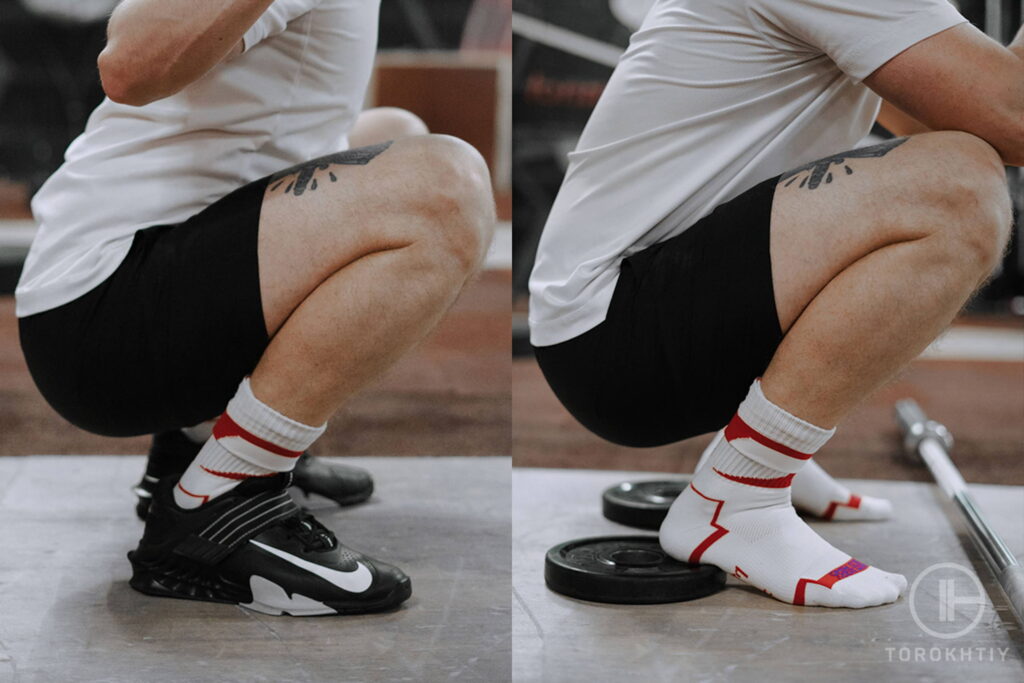
3. Tips:
Make sure to regularly reassess the height of the elevated surface you’re working on. Depending on your needs or limitations, squatting on a higher or lower surface can help you reach your goals faster.
4. Note:
Make sure you consult with a fitness professional or healthcare provider, like your physician if you have any pre-existing conditions or concerns about elevated squats.
10 Alternatives of squatting with plates under heels
Alternatives to squatting with heels on plates may include some of the following:
1. Weightlifting Shoes
We’ve shown you before that we have an article about the top 10 weightlifting shoes out there. These are designed to provide ankle support and facilitate proper squatting and lifting mechanics.
2. Heel Lifts or Inserts
There are heel lifts or inserts that you can place inside your regular shoes that will help you achieve a similar stimulus to an elevated heel squat. In the same idea, we recommend flat sole shoes for lifting.
3. Barefoot Squats
Performing squats barefoot comes with another idea, the idea of helping you improve on one of the problems or issues that bring athletes to elevated heel squats, their ankle mobility. Barefoot squats will aid you on reaching the ankle mobility that will help you move better and safer.
4. Goblet Squats
Holding a dumbbell or kettlebell close to your body engages similar muscle groups without the need for elevated squats by helping you keep an upright torso, on these you can add the ¨narrow squat¨ stance for working the anterior part of your legs harder. You can also perform goblet squats with plates under heels for extra muscle engagement.
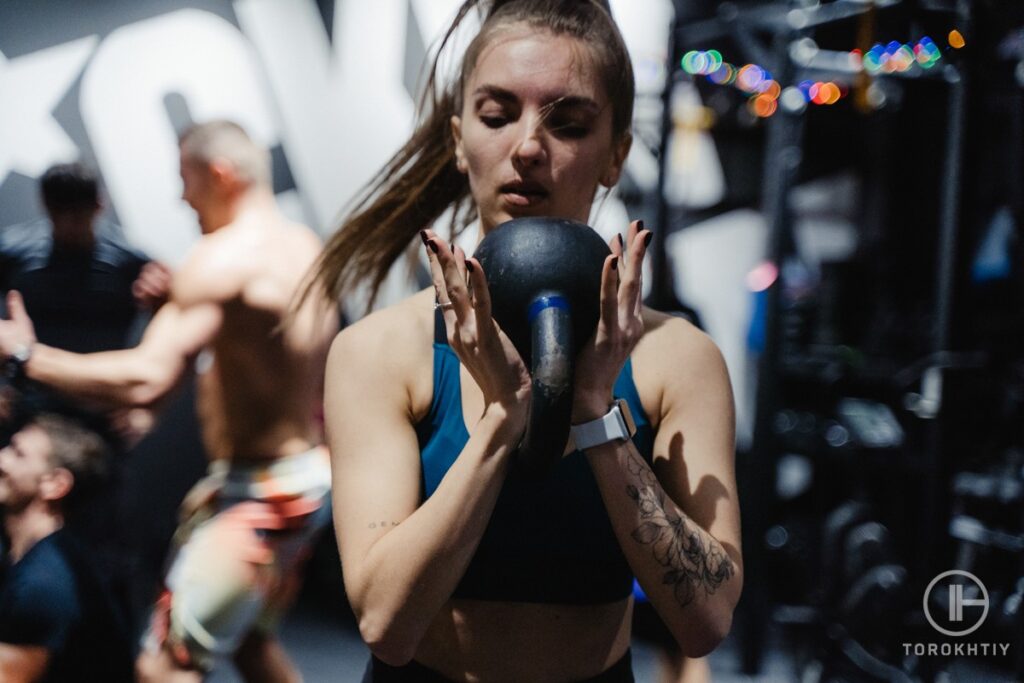
5. Assisted Squats
If mobility or depth is the issue, you can perform assisted squats holding onto a pole or a bar to assist you during the squat.
6. Box Squats
Similar to assisted squats, the Box Squat or Half Squat cuts the range of motion in half so you can focus on keeping your torso upright and maintain proper form.
7. Reverse Lunges
If your focus is on the muscle groups working on the elevated heel squats, then reverse lunges also work the quadriceps and glutes and these can also help you have a more balanced strength work by being unilateral.
8. Step-Ups
Step ups onto a box, bench or elevated surface is a great leg exercise and promotes ankle mobility improvement.
9. Calf Raises
As with step ups, calf raises work on flexion and dorsiflexion of the ankle, if performed regularly, you can get an improvement on ankle mobility with time.
10. Incline Leg Press
In classical gyms there’s always a leg press. These machines simulate de stimulus of an elevated heel squat.
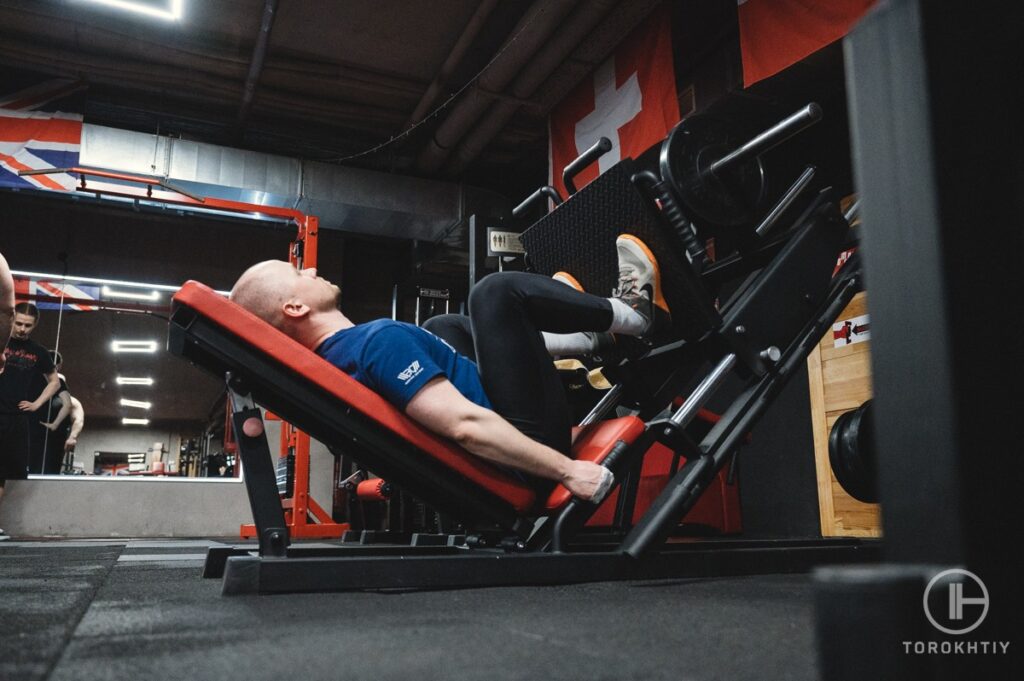
FAQ
What does putting weights under your heels do when squatting?
Squats with heels on plates or wearing weightlifting shoes promotes ankle mobility, improves your squat depth and also alter the biomechanics of the movement. This technique helps you have an upright torso and for some can reside the stress squatting has on their knees. These squats target the quadriceps and glutes.
Is it OK to squat with plates under heels?
Yes, squatting with plates under the heels is generally ok, it can have a big benefit on those with limited ankle mobility. However, it’s always important to keep a proper technique during the squat and always monitor your comfort while performing them. Make sure you consult a professional before adding these to your leg day or squat sessions.
Is it better to squat with heels elevated or flat?
This choice is more of an individual preference and goals. Elevated heels target a specific muscle group that is also engaged during flat feet squats but in a more focused way. However, squatting with flat feet is a more natural and suitable motion. Consider always your comfort, goals and biomechanics before choosing a preferred squat.
Conclusion
Squatting with plates under heels is a great way to engage the quads and glutes in a more focused manner, adding these to your training session can help you prevent plateauing and will give you a different stimulus on your workouts. What do you think? Have you ever tried squats standing on plates? Tell us all your experience and ask all the questions you may have on these in the comment section below.
Also read:
Referenses:
- ¨The effect of elevating the heels on spinal kinematics and kinetics during the back squat in trained and novice weight trainers¨ Mark Sayers University of the Sunshine Coast. ¨https://www.researchgate.net/publication/340016305_The_effect_of_elevating_the_heels_on_spinal_kinematics_and_kinetics_during_the_back_squat_in_trained_and_novice_weight_trainer¨, March 2017.
- ¨How to squat? Effects of various stance widths, foot placement angles and level of experience on knee, hip and trunk motion and loading¨ Silvio Lorenzetti, National Library of Medicine, ¨https://www.ncbi.nlm.nih.gov/pmc/articles/PMC6050697/¨ July 2018.
- Ribeiro, Alex S. PhD; Santos, Erick D. MSc; Nunes, João Pedro MSc; Nascimento, Matheus A. PhD; Graça, Ágatha MSc; Bezerra, Ewertton S. PhD; Mayhew, Jerry L. PhD, ¨A Brief Review on the Effects of the Squat Exercise on Lower-Limb Muscle Hypertrophy¨, Strength and Conditioning Journal, February 2023.
- ¨The Effects of a Heel Wedge on Hip, Pelvis and Trunk Biomechanics During Squatting in Resistance Trained Individuals¨ Jesse M Charlton, ¨https://pubmed.ncbi.nlm.nih.gov/28538320/¨ June 2017.
- ¨Effect of Different Heel Plates on Muscle Activities During the Squat¨ Woen-Sik Chae Kyungpook National University, ¨https://www.researchgate.net/publication/315692187_Effect_of_Different_Heel_Plates_on_Muscle_Activities_During_the_Squat¨ June 2007.
- Photo by workoutplanto pinterest.com, photo by Taralaferrara pinterest.com
Why Trust Us?
With over 20 years in Olympic weightlifting, strength training, nutrition coaching, and general fitness our team does its best to provide the audience with ultimate support and meet the needs and requirements of advanced athletes and professional lifters, as well as people who strive to open new opportunities and develop their physical capabilities with us.
By trusting the recommendations of our certified experts in coaching, nutrition, and sports training programming, as well as scientific consultants, and physiotherapists, we provide you with thorough, well-considered, and scientifically proven content. All the information given in the articles concerning workout programming, separate exercises, and athletic performance, in general, is based on verified data.
The product testing process is described in more detail here.
Author: Sergii Putsov
Head of Sport Science, PhD
Best Results: Snatch – 165 kg,
C&J – 200 kg
Sergii Putsov, Ph.D., is a former professional weightlifter and National team member, achieving multiple medals in the 94 kg weight category at national competitions. With a Master’s degree in “Olympic & Professional Sport Training” and a Sport Science Ph.D. from the International Olympic Academy, Greece, Sergii now leads as the Head of Sport Science. He specializes in designing training programs, writing insightful blog articles, providing live commentary at international weightlifting events, and conducting educational seminars worldwide alongside Olympic weightlifting expert Oleksiy Torokhtiy.
Reviewed by: Oleksiy Torokhtiy
Olympic Weightlifting Champion, PhD in Sport Science
Best Results: Snatch – 200 kg,
C&J – 240 kg
Oleksiy Torokhtiy is a professional athlete boasting 20 years of experience in Olympic weightlifting. With multiple European and World titles under his belt, he has showcased his prowess in two Olympic Games (Beijing 2008 and London 2012). Upon concluding his illustrious career, Oleksiy dedicated himself to coaching. By 2022, he had conducted over 200 weightlifting seminars worldwide. He is the visionary behind an international sportswear and accessories brand known for its motto, “Warm Body Cold Mind.” Additionally, he is an esteemed author and the creator of a series of training programs and eBooks.




Still have questions after reading our article? Unlock your full potential by engaging with our experts and community! Don’t hesitate — leave a comment below and Sergii Putsov will provide a personalized answer and insights to help you reach your goals.